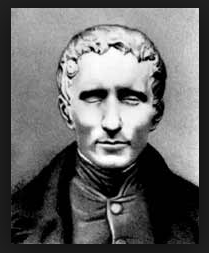
Louis Braille was born on January 4, 1809, in Coupvray, France. He is the inventor of the braille code, and students of all ages can read and learn about him in many titles in the Bookshare library.
At age 16, Louis attended the National Institute for Blind Youth in Paris. He and other blind students would read by tracing raised letters in print with their fingers. Writing required memorization of these letter shapes to reproduce them on paper. The task of reading and writing were painfully slow, and few blind students mastered the technique. Some say that Louis would poke holes in paper trying to come up with a more efficient way to represent letters and numbers tactually.
Louis spent three years improving upon the invention of Charles Barbier, a retired artillery officer, whose note-taking system used embossed dots to represent sounds. Today, Louis’s braille code is used in almost every country in the world and adapted to most known languages. Louis Braille was a great inventor, a teacher, a researcher and an accomplished musician. He died on January 6, 1852, at the age of 43, and each January we celebrate his legacy.
Louis Braille: The Boy Who Invented Books for the Blind by Margaret Davidson
Louis was 12 years old and blind, but he made up his mind that he was going to invent an easy way for all blind people to read and write. It took him three years to work out his alphabet of raised dots.
The Picture Book of Louis Braille by David Adler
A biography of the inventor of the braille code, for kids.
Instructional Strategies for Braille Literacy by Diane P. Wormsley and Frances M. D’Andrea
Braille instructors can find specific and practical strategies for teaching braille reading and writing. This includes learning general guidelines and strategies; fostering emergent learning; making the transition from print to braille; teaching braille to students with special needs and those who speak English as a second language; assessing the literacy skills of students who are blind or visually impaired; and learning about technology and braille.

Be First to Comment